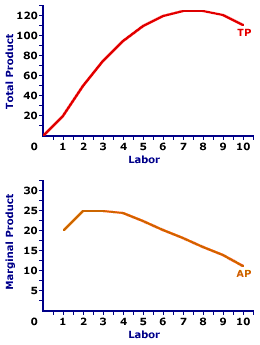
|
|
UNEMPLOYMENT: The general condition in which resources are willing and able to produce goods and services but are not engaged in productive activities. While unemployment is most commonly thought of in terms of labor, any of the other factors of production (capital, land, and entrepreneurship) can be unemployed as well. The analysis of unemployment, especially labor unemployment, goes hand-in-hand with the study of macroeconomics that emerged from the Great Depression of the 1930s.
Visit the GLOSS*arama
|
|


|

|
                           TOTAL PRODUCT AND AVERAGE PRODUCT: A graphical connection between the total product curve and the average product curve stating that the slope of a line between the origin and any point on the total product curve is equal to the average product. Imagine a ray shooting from the origin and hitting the total product curve. As this ray hits each point on the curve, remaining anchored at the origin, the slope of the ray changes, and the slope of this ray is average product. What is the logic behind this total-average relation? The slope of any line is the rise over the run, in this case the change in total product divided by the change in variable input. This, by the way, is the verbal description of marginal product. However, because the line is anchored at the origin, any changes in total product and variable input are changes from zero. In other words, the "change in" calculations are not incremental changes, but rather the total values up to that point of production--total product and the total quantity of the variable input used to produce the total product. This is simply the calculation of average product. Making Tacos| Total and Average Product |  |
A graph should help illustrate the relation between total product and average product. The graph to the right is the hourly production of Super Deluxe TexMex Gargantuan Tacos (with sour cream and jalapeno peppers). The top panel of the graph is the total product curve. The bottom panel is the average product curve.For the relation between these two curves, a few buttons need to be clicked. - After clicking the [A] button, a line connecting the origin with a point on the total product curve is revealed. This point is a total product of 120 Gargantuan Tacos resulting from employing 6 workers. The slope of this line is equal to 10 tacos per worker. This corresponds exactly with the average product of 10 tacos per worker.
- Clicking the [B] button displays a second line connecting the origin with a total product/variable input quantity of 125 Gargantuan Tacos and 8 workers. The slope of this line is equal to 15.83 tacos per worker, which exactly to the average product of 15.83 tacos per worker.
- Clicking the [C] button displays a third line connecting the origin with a total product/variable input quantity of 110 Gargantuan Tacos and 10 workers. The slope of this line is equal to 11 tacos per worker, which is exactly to the average product of 11 tacos per worker.
Marginal and AverageOne additional button that needs to be clicked is the one labeled [Marginal]. This button displays a relatively important line. Because this line connects the origin and the total product curve, like the other lines presented here, the slope measures average product. However, this line is also tangent to the total product curve. As a tangent, the slope of this line is also the slope of the curve at the point of tangency. But the slope of the total product curve is marginal product.What does this mean? It means that this particular line measures both average product and marginal product. It means that at 2.5 workers, marginal product and average product are exactly the same.

Recommended Citation:TOTAL PRODUCT AND AVERAGE PRODUCT, AmosWEB Encyclonomic WEB*pedia, http://www.AmosWEB.com, AmosWEB LLC, 2000-2024. [Accessed: April 28, 2024].
Check Out These Related Terms... | | | |
Or For A Little Background... | | | | | | | |
And For Further Study... | | | | | | | | | | |
Search Again?
Back to the WEB*pedia
|



|

|
BROWN PRAGMATOX
[What's This?]
Today, you are likely to spend a great deal of time browsing through a long list of dot com websites wanting to buy either a birthday greeting card for your aunt or a wall poster commemorating the moon landing. Be on the lookout for deranged pelicans.
Your Complete Scope
This isn't me! What am I?
|

|
|
The first U.S. fire insurance company was established by Benjamin Franklin in 1752 in Philadelphia.
|

|
|
"The roots of education are bitter, but the fruit is sweet." -- Aristotle
|

|
LRMC
Long Run Marginal Cost
|

|
|
Tell us what you think about AmosWEB. Like what you see? Have suggestions for improvements? Let us know. Click the User Feedback link.
User Feedback
|


|


